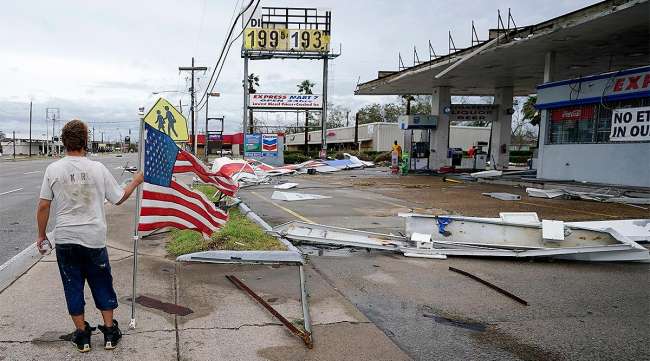Senior Reporter
Diesel Jumps 1.5¢ After Hurricane Laura Ravages Gulf Region

[Stay on top of transportation news: Get TTNews in your inbox.]
The price of diesel jumped by 1.5 cents nationwide to $2.441 a gallon, the Energy Information Administration reported Aug. 31, as much of the nation’s oil exploration and refining capacity was shut down because of two severe-weather events.
Hurricane Laura and Tropical Storm Marco wreaked havoc after coming ashore off the Gulf of Mexico, near where much of the country’s gasoline and diesel is produced.
Trucking’s primary fuel increased for just the second time in the past seven weeks.
Diesel cost $2.426 a gallon last week. Still, at $2.441, the price is 53.5 cents less expensive than it was at this time last year. Gasoline jumped even more significantly, by 4 cents nationwide, highlighted by an 8.5-cent increase in the Central Atlantic.
The diesel price increased in all 10 regions that EIA surveys each week, and nine saw an increase of more than a penny. The most significant jump was in the Midwest, where diesel climbed 2.1 cents to $2.329. Diesel there is 54.5 cents per gallon less expensive than last year. The smallest increase was in New England, just two-tenths of a cent to $2.622. Diesel in that region is 40.5 cents less expensive than a year ago.

Natural gas and propane join electric power as alternatives to diesel. Host Seth Clevenger talks with Chad Lindholm of Clean Energy and Stuart Weidie of Alliance Autogas. Hear a snippet, above, and get the full program by going to RoadSigns.TTNews.com.
The most expensive diesel continues to be in California, where the price increased 1.1 cents to $3.276. It is 60.9 cents less expensive there than it was a year ago. The least costly diesel in the nation remains along the Gulf Coast, where the price increased 1.4 cents to $2.188 — 55.2 cents less expensive than at this time in 2019.
The Gulf Coast boasts the lowest price in part because it is home to much of the country’s oil and gasoline production and a large share of the refining capacity.
Laura came ashore near Lake Charles, La., as a Category 4 hurricane Aug. 27, making it the most powerful storm to hit that state in decades, causing hundreds of millions of dollars worth of damage. However, oil industry analyst Phil Flynn, senior market analyst at The Price Futures Group in Chicago, told Transport Topics it appears most of the nation’s refining capacity was spared extensive damage, and those facilities should be back in operation relatively soon.
“From what we are hearing, the refinery damage is not as bad as we had anticipated. A lot of the refineries have restarted,” Flynn said. “However, it is maintenance season for the refineries, and if one goes down, I think the other refiners can pick up the slack.”
Refineries typically plan maintenance in the spring and fall to gear up for more robust fuel demand in the summer and winter months.
Oil Price Information Service founder and analyst Tom Kloza told TT the aftermath of Hurricane Laura would linger for several weeks as refineries repair the damage, but he said prices likely will remain stable as tens of millions of barrels of oil are in storage.
“Thanks to COVID, thanks to the time of year, and the lack of probably more than a million barrels a day of downed capacity, it’s back to the status quo,” he said. “Gas and diesel products have pretty much ignored the storm. Gasoline and diesel are just stuck in a slog. We’re going to see very little movement.”
The price of West Texas Intermediate crude oil, the industry benchmark, closed Aug. 31 at $42.61 a barrel, staying in the $39-to-$43 range it has been in for the past several months. Still, WTI is 35% lower than what it was a year ago when it closed at $65.65 a barrel. The downturn in the economy in the spring is evidenced by numbers released by EIA in its June energy report. Diesel usage in that month was just 3.49 million barrels per day, the lowest June since 1999. Part of the drop is attributed to the parking of more than 500,000 school buses, with thousands of schools closed for the summer after being shut down in March, April and May because of the coronavirus. Adding to the decline in diesel usage is the devastation of the over-the-road motor coach industry caused by the virus. An estimated 36,000 buses have been idled as thousands of companies have seen business dry up.
Meanwhile, domestic oil production is starting to slowly climb back up after dropping significantly because of the pandemic. EIA reported that the nation has produced an average of 10.9 million barrels of oil per day during the past month. This is after daily production in May slumped to 10 million barrels.
Want more news? Listen to today's daily briefing:
Subscribe: Apple Podcasts | Spotify | Amazon Alexa | Google Assistant | More




